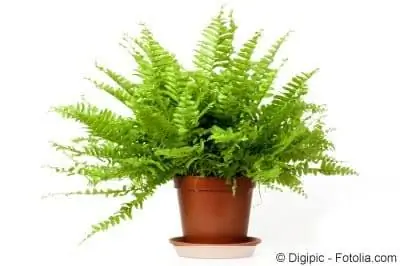- Author admin [email protected].
- Public 2023-12-17 03:39.
- Last modified 2025-01-24 12:45.
With its interesting appearance, which results from the delicate and slightly wavy or even very curly leaflets, the sword fern is one of the most popular fern species. However, the fern is not a really easy plant to care for, as it places some demands on both the location and the acclimatization.
The sword fern is demanding to care for - but still not as sensitive as many other fern species. Whether it thrives or wilts quickly depends on the location and care, but also on the right time to buy it. The best date for shopping is spring, because then the fern still has enough time over the summer to get used to the climate of the apartment from the greenhouse air without being confronted with heating air straight away.
Species
The sword fern is available in numerous species, but they only differ in their size and the shape of the pinnate leaves and fronds; the care is identical.
Location
The sword fern does not like strong sunlight or a location that is too dark. A location that offers partial shade is perfect for the fern - for example on an east or west window. It is not uncommon for ferns to be found in stairwells. This is only okay for the plant if it is not exposed to drafts. In summer, warm temperatures in the room are not a problem for the fern and in winter it can also tolerate slightly cooler air without any problems. However, if the fern is in a heated room, it should be sprayed regularly with water. Alternatively, an electric humidifier can also be set up. If the sword fern is exposed to direct sunlight, the leaves get brown spots and dry out. On the other hand, if it is too dark, the growth of the entire plant will be significantly reduced. A bright location that offers a few hours of sunshine a day is best for the sword fern. It is also important that the sword fern is not placed too close to radiators in the apartment!
Tip:
A bright bathroom with daylight is the perfect location for the sword fern, because it receives both light and the necessary humidity and warmth.

The perfect location for the fern
- it's not too dark
- do not expose it to direct sunlight or heating heat
- protects it from drafts
- is bright
Substrate & Soil
Perfect for the sword fern is a substrate that has a high proportion of humus and peat. To do this, you can mix commercially available potting soil with compost - for example from your own garden - and also add a third of peat. Older plants are content with normal potting soil if the location is ideal and the humidity conditions are optimal.
Repotting
Whenever the roots of the sword fern completely fill the planting container, repotting is necessary so that growth is not restricted. For older plants, it is usually enough to repot them every three years. Young plants, on the other hand, need a larger planting container every year. However, the new plant container should always be only a few centimeters larger than the previous plant container. Repotting should always be done in spring, before the plant's main growing season. This ensures that the sword fern can acclimatize optimally after repotting and that the individual fronds do not become discolored. Repotting and inserting newly purchased ferns should follow a fixed pattern. First, the root ball is removed as completely as possible from the old substrate. A new drainage layer is then created in the new planter. The pot is then half filled with the substrate mixed from soil, compost and peat, then the fern is inserted. The remaining cavities are filled with substrate. It is important to then press the soil down well. The last step is to water the plant vigorously with lime-free water.
Tip:
Parallel to repotting, you can divide the roots of the older plants in order to rejuvenate and multiply the plant.
Fertilize
It is important for the sword fern that it is supplied with fertilizer from March to October. Liquid and slow-release fertilizers are ideal for the fern. The use of natural nutrient suppliers such as horn shavings or compost for fertilization is less favorable. Since the fern rests during the cold season, there is no need to fertilize to prevent over-fertilization. An excessive supply of nutrients can cause the fern to develop yellowish fronds.
Fertilization takes place
- from March to October with standard liquid fertilizer according to the packaging instructions
- not at all in the cold season to avoid over-fertilization
- too intense, when the fronds turn brownish
Cutting
The sword fern does not necessarily need pruning. If necessary, the fronds that are dry or have brown tips are shortened by a few centimeters. If necessary, the lush growth of the sword fern can also be corrected with a cut. To do this, the roots of the plant are carefully trimmed during repotting and then placed back in the old planter with new substrate.

You can also easily regulate the lush growth of the sword fern with one cut. This measure is often necessary, for example, if the plant's fronds have already reached a circumference of over 1 meter. To do this, carefully trim the roots of the fern and then put the plant back in the old planter.
Pouring
The plant has a very high water requirement, but cannot tolerate waterlogging. The plant should be watered when the upper layer of soil has noticeably dried out. To avoid waterlogging, you can take precautions when repotting by placing potsherds on the bottom of the planter as the bottom layer in front of the substrate. This allows excess irrigation water to drain away better from the roots. Watering should always be done with water that is as lime-free as possible. The sword fern gets its moisture requirements not only from the irrigation water, but also from the air. In our regions, this can be taken care of by regularly spraying the fern with a water sprayer. Alternatively, the room humidity can be permanently increased using an air conditioning unit in order to provide the fern with optimal conditions.
When watering you should
- Avoid waterlogging
- consider the high water requirement
- provide a supplement to water absorption by spraying the plant
Tip:
It may make sense to choose a location next to an aquarium or an indoor fountain in order to provide the fern with the necessary humidity.
Propagate
Propagation can be done by root division, in which the root ball of an older plant is cut and the pieces of the fern, which are as equally sized as possible, divided into different planters. Alternatively, you can carefully separate the so-called runners, which form older plants, in spring and plant them in a small container with humus-rich and peat-rich soil. Propagation by sowing is possible, but very complicated and time-consuming.
Wintering
The sword fern is a tropical plant and should only be placed in the garden, on the balcony or on the terrace, protected from the wind in summer. Even in winter, the room temperature must not fall below 10 °C, although the tropical plant takes a break from vegetation in the cold season. Under no circumstances should fertilization be carried out during the winter rest phase. The fern must not be placed near radiators and sufficient humidity should be ensured, optionally by spraying the plant with a water sprayer. If the sword fern is purchased in winter, it often has problems switching from the air-conditioned sales rooms to the heated interior rooms. That's why you shouldn't buy the sword fern in winter at all.
Tip:
Even in winter, the sword fern should not be exposed to long-term, albeit weaker, sunlight, which is why south-facing windows are unsuitable as a location in winter.
Pests and diseases
Inadequate water supply punishes the fern with dried out fronds, which can, however, be cut off. Yellow leaflets indicate that the room temperature is too low. If the leaflets fall off, the reason may be that the location is too dark. Limescale spots on the leaves can be avoided by spraying with lime-free water. If the location is chosen incorrectly - for example, the plant is too dark or the humidity is too low - sword ferns are susceptible to infestation by aphids as well as scale insects or spider mites.
Frequently asked questions
Is the sword fern poisonous?
Sword ferns are slightly poisonous. However, consumption can be followed by vomiting and nausea in small children or cats. In this case, a poison control center should be contacted immediately!
Is the sword fern really an indoor climate improver?
Yes, the sword fern, for example, is able to absorb harmful gas particles through its leaves and return them to the room air when converted into oxygen. The plant can therefore significantly improve the indoor climate.






